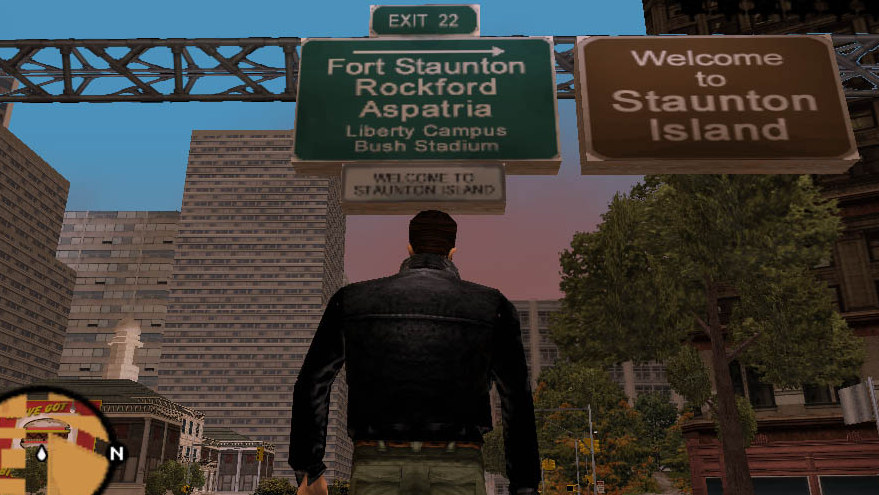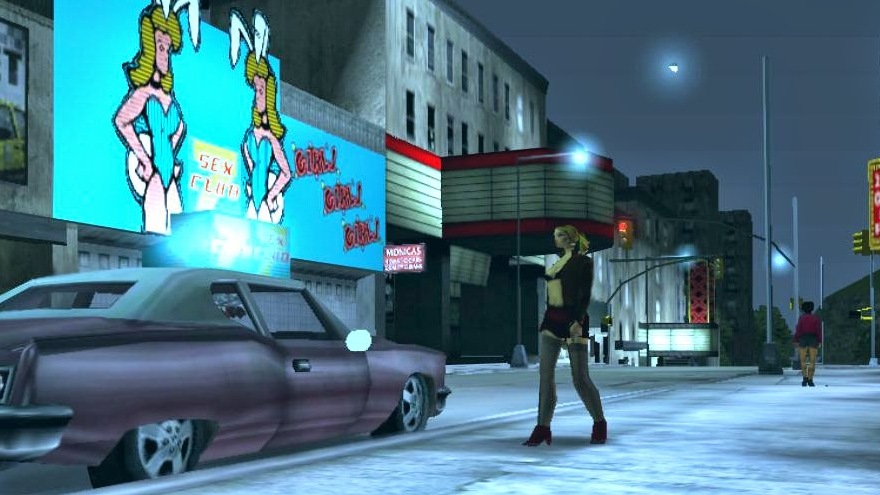This article is part of PS2 Week, a full week celebrating the 2000 PlayStation 2 console. To see other articles, go here.
///
Up until Grand Theft Auto III (2001), it was standard to classify videogames by their central mechanics. There were stealth games, platformers, shooters, racing games, action-RPGs, turn-based RPGs, fighters, puzzle games, action-adventure games—and the expectation was that every game would feature a whole range of genre-informing actions and rules, typically interspersed with sections devoted to “story.” The problem is that this naming structure was a presupposition in itself: what if you wanted to do all of these things at the same time? What if you wanted to make the sights and sounds just as important as the shooting or the driving?
In a 2001 interview with IGN (one of the few he’s ever given) Rockstar co-founder Sam Houser honed in on his priority of making sure Grand Theft Auto III had “a look, a sound, a story and a feel that worked.” Working alongside film directors, writers, video producers, audio producers, and other connections from outside the industry, Rockstar created a sort of ragtag multimedia mash-up that, aside from boasting new tech, came together as a well-oiled, ultra-violent machine. Looking back on it now, the approach had an almost DIY punk aesthetic to it, rejecting the insular pillars of traditional game design and reaching outside the videogame sphere for direction. The list of artistic influences that show up in Grand Theft Auto III would read like the programming schedule for a Gen X fever dream: it pulls from Scorsese gangster flicks, house music and hip-hop, exploitation cinema, sketch comedy, chase films, and the city of New York itself, just to name a few.
It’s easy to forget now, but the open-world game wasn’t a novel concept when Grand Theft Auto III was released. Games like Driver (1999) and Crazy Taxi (1999) had already put us behind the wheels of beefy vehicles to cruise freely through city streets. The Legend of Zelda: Ocarina of Time (1998) and Shenmue (2000) had already built open worlds to explore and characters to interact with. Even previous Grand Theft Auto installments featured comparably-sized worlds: when you look at Grand Theft Auto 2 (1998), for instance, there are very few base mechanics to differentiate it from the third. They had similar maps, similar missions, and similar lines of progression. If there was any unique accolade to give Rockstar after the release of Grand Theft Auto III, it’d be for their ability to mesh its various systems with world elements that felt diegetic.
“The cleverness of the GTA design is in the glue,” Rockstar vice president Dan Houser said in a 2011 interview with IGN, “not in the things that have been held together.” Most of Grand Theft Auto III’s proverbial adhesive came in the form of its then-groundbreaking data streaming system, which allowed the game to quickly retrieve information from the PS2 disc without cutting to a load screen. This meant that a player could walk up to a vehicle, press the triangle button, then seamlessly drive that vehicle off into the sunset without any interruptions. It was a major technical accomplishment for the time, but Rockstar backed its impact with subtler elements that helped to flesh out the world as a sandbox of possibilities. For one, they hid collectible pigeons across the city to encourage deep exploration in a pre-Achievement era. They placed ramps and hills across the map, allowing players to pull off stunts if they were on the run or just looking to satisfy their inner Evel Knievel. All of these ingredients helped to encourage a constant crossing-over between videogame genres. In tandem with the multimedia eclecticism of its world, Grand Theft Auto III conjured the illusion of “realness”: that the player’s actions had some semblance of weight in a world that lived and breathed, even if only in a digital sense.

In its immediate aftermath, this newfangled sense of realism set off a widespread moral panic about the impact of violent videogames. There had been ultra-gruesome splatterfests before Grand Theft Auto III, but something about granting players the agency to pick up, have sex with, and then murder prostitutes gave this game a disturbing gravity. “While the violent nature of the game will surely turn some people off and kids simply shouldn’t be allowed anywhere near it, Grand Theft Auto III is, quite simply, an incredible experience that shouldn’t be missed by anyone mature enough to handle it,” Jeff Gerstmann said in a 2001 review. While the most infamous outbursts of panic came in the form of Jack Thompson-types and parental word-of-mouth, there was a sense even among the critics and players that Grand Theft Auto III’s pioneering openness made it somehow dangerous.
Grand Theft Auto III was so alien that people didn’t only struggle to comprehend its immediate impact, but also had trouble tracing its legacy. At a point in time not too long ago, practically every reference to a 3D open-world action game after Grand Theft Auto III came with the words “GTA clone.” These sorts of clunky sub-genre monikers come around all the time. They’re used to supply more of those little boxes to tick when categorizing videogames. There’s the “Metroidvania,” a portmanteau of Metroid and Castlevania, meaning that at some point in the game progress will be blocked until the player finds a specific item. There’s also the “roguelike,” named after Rogue (1980), which is differentiated from a regular RPG due to features like permadeath and world randomization. “GTA clone” became another one in this long list.
The term worked well enough at first: games like Dead to Rights (2002), Mafia (2002), Saints Row (2006), and even Spider-Man 2 (2004) featured action-oriented sandboxes and looked a hell of a lot like Grand Theft Auto III. These games typically deviated from the formula in one way or another: Saints Row was (somehow) more crass than Grand Theft Auto, for instance, and Spider-Man 2 let you swing around the city on webs. For the most part, though, these successors felt like spiritual derivatives. Eventually, so many videogames used open worlds that the category outgrew the scope of Grand Theft Auto altogether. To call a game like Saints Row IV (2013) a “GTA clone” these days would be like calling a platformer a “Mario clone”: while the influence is clearly present, the genre has evolved so much that the comparison is practically irrelevant.
Still, Grand Theft Auto III’s categorical specter continues to loom over the open-world genre. As late as 2010, when Rockstar released the spaghetti western-themed Red Dead Redemption, critics lovingly mocked it as “Grand Theft Horse”. It was, after all, another open-world game filled with shooting and driving, except that instead of cars you galloped around on a trusty steed. Red Dead Redemption was far from another “GTA clone,” but its similar mechanical makeup made the comparison difficult to resist.
Now, almost 15 years after its release, there’s still the urge to describe open-world games by using Grand Theft Auto III as a frame of reference. In other media, this can be a helpful shortcut: point a shoegaze newbie toward My Bloody Valentine and the Cocteau Twins, and it becomes much easier for them to delve into groups like Slowdive or The Jesus and Mary Chain. But when your genre of origin comes pre-packaged with such specific expectations, the nomenclature becomes a straitjacket: think, for instance, of the baggage that comes with a pejorative genre designation like “walking simulator”. The name may have started as a joke for emotionally-charged first-person games like Dear Esther (2012) and Gone Home (2013), but it’s grown into a stigma of its own.

To view Grand Theft Auto III as the mere ancestor to a couple back-of-box features is to undermine the details that fuel its experiences. Back in 2001, there was no linguistic scaffolding that could handle the possibilities it presented. But now, as videogames get even more complex—tackling subjects like mortality, fraying relationships, first loves—it becomes increasingly inept to reduce their value to the details of their mechanical inner-workings. Instead, the act of evaluating a videogame should be an active, personal process that seeks to expand instead of contract the possibilities of interactive media. The eventual upgrade from “GTA clone” to “open-world” was a step in the right direction. But the open-world designation has its own limitations: with open universes just on the horizon, even that phrase seems destined to fail.
